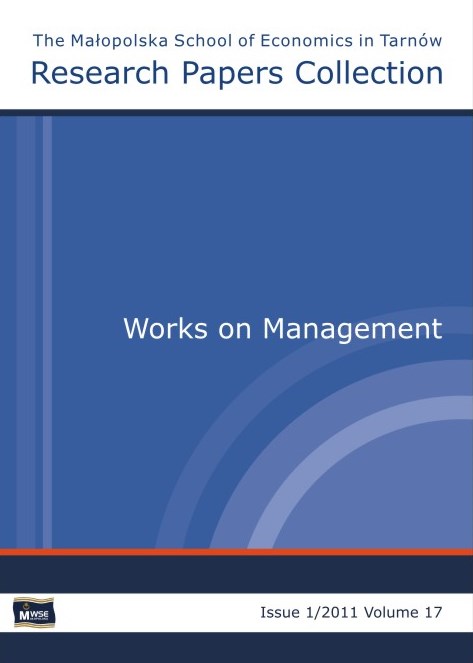Abstract
The paper discusses the following: the preliminary notes, the analysis of preferences as a universal concept of aggregate assessment, the ranking method, the score method, the quotient standardisation method. The preliminary notes give an interpretation of aggregate assessment. It consists in general assessment of the value of an object by combining individual assessment criteria into one entirety. Aggregate assessment has broad applications, in reference to both projects and processes, phenomena, and all types of objects. It is used in diagnostic research and in making decisions (related to, e.g., the selection of the optimum project variant). Then, the analysis of preferences as a universal concept of aggregate assessment is provided. Analysis of preferences in common understanding is a research approach which consists in qualifying objects according to a specific scale, which is expressed in hierarchy of importance of the objects. This part of the text presents also the research process cycle. Its main components are: the object, a set of objects or a system, the values characteristic for the object, assessment criteria, aspects of preferences, the procedure of calculation of the weighted value of the object. Then the ranking method is discussed which is used for qualification of projects (project variants) in the scale of natural numbers. The research workflow in the ranking method is as follows: 1) defining the ranking range, 2) collecting the data for ranking, 3) preferential organising (calculating total ranks, calculating averaged ranks, determining the position of the project in the ranking). Then the score method is discussed along with its special form of the score aggregation. Qualification is done here, unlike in ranking, in the scale of real or integral numbers. The research proceedings in the score aggregation method follows the following steps: determining the universal formula for the weighted value, score standardisation for selection criteria, aggregate assessment (calculation of the IPPi index), categorisation of the IPPi index. The basic text is concluded with the quotient standardisation method discussed. This method is the aggregate approach of the index-based assessment of projects. The essence of quotient standardisation is in unifying values of individual selection criteria by referring them to predefined master values. The central step in this method is calculation of the indexes Zi and Zi*. They constitute the simple or weighted arithmetic mean of the aggregate assessment of the project. The project with the highest index is the optimum solution.
References
Bąk A., Dekompozycyjne metody pomiaru preferencji w badaniach marketingowych, Wydawnictwo Akademii Ekonomicznej im O. Langego we Wrocławiu, Wrocław 2004. ISBN 83-7011-698-1.
View in Google Scholar
Frankfort-Nachmias Ch., Nachmias D., Metody badawcze w naukach społecznych, przeł. E. Hornowska, Wydawnictwo Zysk i S-ka, Poznań 2001. ISBN 83-7150-702-X.
View in Google Scholar
Gatnar E., Symboliczne metody klasyfikacji danych, Wydawnictwo Naukowe PWN, Warszawa 1998. ISBN 83-0112-428-8.
View in Google Scholar
Kukuła K., Metoda unitaryzacji zerowanej, Wydawnictwo Naukowe PWN, Warszawa 2000. ISBN 83-01-13097-0.
View in Google Scholar
Noworol Cz., Analiza skupień w badaniach empirycznych. Rozmyte modele hierarchiczne, Państwowe Wydawnictwo Naukowe, Warszawa 1989. ISBN 83-01-10009-5.
View in Google Scholar
Ogilvy J.A., Creating Better Futures. Scenario Planning as a Tool for a Better Tomorrow, Oxford University Press, New York 2002. ISBN 0195146115.
View in Google Scholar
Pawełek B., Metody normalizacji zmiennych w badaniach porównawczych złożonych zjawisk ekonomicznych, Wydawnictwo Uniwersytetu Ekonomicznego w Krakowie, Kraków 2008. ISBN 978-83-7252-398-3.
View in Google Scholar
Pillkahn U., Using Trends and Scenarios as Tools for Strategy Development, Publicis Corporate Publishing, Siemens, Erlangen 2008. ISBN 9783895783043.
View in Google Scholar
Ralston B., Wilson I., The Scenario Planning Handbook. A Practitioner’s Guide to Developing Strategies in Today’s Uncertain Times, Thomson South-Western, Mason 2006. ISBN 0324312857.
View in Google Scholar
Stabryła A., Categorization as an Instrument in Managing Company Development Capacity, „Argumenta Oeconomica Cracoviensia” 2005, nr 3.
View in Google Scholar
Stabryła A., Zarządzanie projektami ekonomicznymi i organizacyjnymi, Wydawnictwo Naukowe PWN, Warszawa 2008. ISBN 978-83-01-14846-1.
View in Google Scholar
Szreder M., Metody i techniki sondażowych badań opinii, Polskie Wydawnictwo Ekonomiczne, Warszawa 2004. ISBN 83-208-1515-0.
View in Google Scholar
Szwabowski J., Deszcz J., Metody wielokryterialnej analizy porównawczej. Podstawy teoretyczne i przykłady zastosowań w budownictwie, Wydawnictwo Politechniki Śląskiej, Gliwice 2001. ISBN 83-88000-89-6.
View in Google Scholar
Walesiak M., Bąk A., Uogólniona miara odległości w statystycznej analizie wielowymiarowej, Wydawnictwo Akademii Ekonomicznej we Wrocławiu, Wrocław 2002. ISBN 83-7011-583-7.
View in Google Scholar
© Copyright by Małopolska School of Economics in Tarnów. The articles are available under the Creative Commons Attribution NonCommercial-NoDerivatives 4.0 International License


